
Havana is the capital and largest city of Cuba. The heart of the La Habana Province, Havana is the country's main port and commercial center. The city had a population of 2,137,847 inhabitants in 2022, and it spans a total of 728.26 km2 (281.18 sq mi) for the capital city side and 8,475.57 km² for the metropolitan zone – making it the largest city by area, the most populous city, and the second largest metropolitan area in the Caribbean region.

Marianao is one of the 15 municipalities or boroughs in the city of Havana, Cuba. It lies 6 miles southwest of the original city of Havana, with which it is connected by the Marianao railway. In 1989 the municipality had a population of 133,016. Marianao is on a range of hills of about 1500 above sea level and is noted for its salubrious climate. The city dates back to 1830.

El Cementerio de Cristóbal Colón, also called La Necrópolis de Cristóbal Colón, was founded in 1876 in the Vedado neighbourhood of Havana, Cuba to replace the Espada Cemetery in the Barrio de San Lázaro. Named for Christopher Columbus, the cemetery is noted for its many elaborately sculpted memorials. It is estimated the cemetery has more than 500 major mausoleums. Before the Espada Cemetery and the Colon Cemetery were built, interments took place in crypts at the various churches throughout Havana, for example, at the Havana Cathedral or Church Crypts in Havana Vieja.
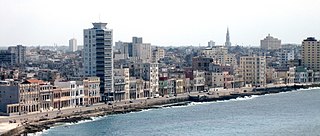
The Malecón is a broad esplanade, roadway, and seawall that stretches for 8 km along the coast in Havana, Cuba, from the mouth of Havana Harbor in Old Havana, along the north side of the Centro Habana neighborhood and the Vedado neighborhood, ending at the mouth of the Almendares River. New businesses are appearing on the esplanade due to economic reforms in Cuba that now allow Cubans to own private businesses.
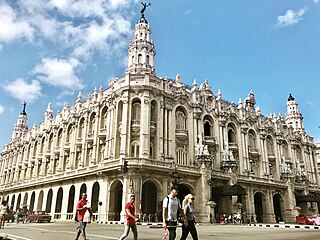
Gran Teatro de La Habana is a theater in Havana, Cuba, home to the Cuban National Ballet. It was designed by the Belgian architect Paul Belau and built by Purdy and Henderson, Engineers in 1914 at the site of the former Teatro Tacón. Its construction was paid for by the Galician immigrants of Havana to serve as a community-social center. Located in the Paseo del Prado, its facilities include theatres, a concert hall, conference rooms, a video screening room, as well as an art gallery, a choral center and several rehearsal halls for dance companies. It hosts the International Ballet Festival of Havana every two years since 1960.

Leonardo Morales y Pedroso was one of the most prominent Cuban architect in Cuba in the first half 20th century. In 1900 he entered and attended pre-university studies at De Witt Clinton High of New York, where he obtained a bachelor's degree. In 1909 he graduated of Bachelor in Architecture from Columbia University. After graduating, he returned to Cuba in 1909 where he worked a time in the local architect firm of Newton & Sola with the architect Thomas M. Newton, who was director of the civil construction section of the Secretary of Public Works during the 2nd American intervention in Cuba. In February 1910, he returned to the United States and obtained a master's degree (Doctor) in Architecture from Columbia University in the State of New York. After obtaining his doctorate in architecture he joined in March 1910 the architecture Company Morales y Mata arquitectos, created in 1907 by his elder brother the engineer Luis Morales y Pedroso in association with the master builder Jose F. Mata. In 1917, after having built more than 30 important buildings, they decided to separate from José Mata, who had to stop working because illness and died a short time later. The company changed its name for Morales y Compañia Arquitectos with his brother the engineer Luis Morales y Pedroso as president and Leonardo as Associate together with other 7 architects. He was able to obtain noteworthy real estate commissions partly because of his family's origin, good social connections and social standing in Havana high society. He was named by the Cuban press of the time as the "Havana's architect" and his architectural style is recognized as the "Morales style". During 50 years Leonardo Morales y Pedroso received around 250 notable architectural commissions, some of them include:

The Court of Neptune Fountain is a fountain adorned with bronze sculptures made by Roland Hinton Perry and Albert Weinert in the late 1890s. Jerome Connor may have assisted in their manufacture. The architects for the project, which was completed in 1898, included John L. Smithmeyer, Paul J. Pelz, and Edward Pearce Casey, while the founding was completed by the Henry-Bonnard Bronze Company. The fountain is located on the west side of the Thomas Jefferson Building, the main building for the Library of Congress in Washington, D.C. The project took three years to complete.

The Lonja del Comercio building in Old Havana, Cuba served as the stock exchange in the capital until the 1959 Cuban Revolution. Today, it is an office building.
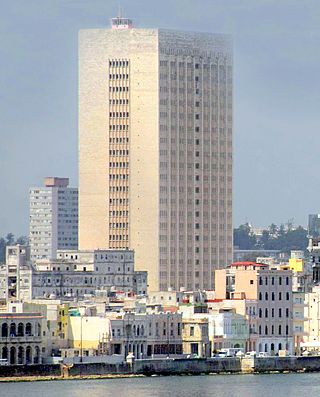
The Hermanos Ameijeiras Hospital, officially the Hospital Clínico Quirúrgico "Hermanos Ameijeiras", is located in Barrio San Lazaro and is the premier hospital in Cuba, its tower prominently visible from the Malecón between the historic center and the uptown Vedado neighborhood. It was opened in 1982.

Paseo del Prado is a street and promenade in Havana, Cuba, near the location of the old city wall, and the division between Centro Habana and Old Havana. Technically, the Paseo del Prado includes the entire length of Paseo Martí approximately from the Malecon to Calle Máximo Gómez, the Fuente de la India fountain. The promenade has had several names; it was renamed Paseo de Martí in 1898 with the island's independence from Spain. Despite the historic references, the people of Havana simply call it "El Prado".
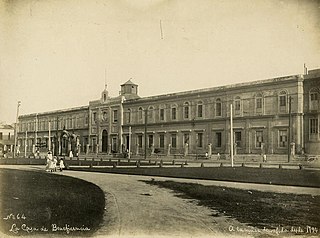
La Casa de Beneficencia y Maternidad de La Habana, was for 270 years Havana's repository of Havana's unwanted children. The House of Charity started during a time when Cuba was experiencing extreme poverty, unemployment, and corruption in the government. Corrupt leaders were plundering the public treasury and little attention was given to social assistance, health, education, or the protection of the poor: "los desamparados".

Colegio Nacional de Arquitectos de Cuba (C.N.A.C.) is a Cuban national institution based in Havana, that grew out of El Colegio de Arquitectos de La Habana.

The Iglesia del Espíritu Santo is a colonial church at #702 Calle Cuba in Old Havana, Havana, Cuba, was built in 1635 on the corner of the corner of Calles Cuba and Acosta. The Espíritu Santo contains some notable paintings including a seated, post-crucifixion Christ on the right wall, and catacombs. It is considered one of the oldest temples in Havana. Free blacks, already numerous, devoted the church to the Holy Spirit in 1638.

Hospital de San Lázaro was a hospital in the city of Havana, Cuba. It dates back to the 17th century, when it served as headquarters for some huts built near the Caleta de Juan Guillén, then known as Caleta de San Lázaro, in an area about a mile outside the city walls.

Barrio de San Lázaro is one of the first neighbourhoods in Havana, Cuba. It initially occupied the area bounded by Calle Infanta to the west, Calle Zanja to the south, Calle Belascoáin to the east, and the Gulf of Mexico to the north, forming the western edge of Centro Habana. According to the 1855 Ordenanzas Municipales of the city of Havana, Barrio San Lázaro was the Tercer Distrito and was Barrio No. 8.

The Colegio de Belén located between 45th and 66th streets, situated next door to the Tropicana nightclub, in Marianao, Havana, was designed in 1925 by the architect Leonardo Morales y Pedroso and his brother the engineer Luis Morales y Pedroso of the firm Morales y Compañía Arquitectos.
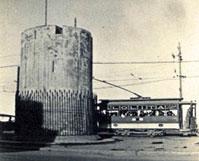
El Torreón de San Lázaro is round tower of masonry built on the shore of the Caleta de San Lazaro. The Torreón de San Lázaro is approximately 4.57 metres (15.0 ft) in diameter and 9.14 metres (30.0 ft) high with embrasures along its wall at the intermediate level and a battlement parapet at the third level roof. It has a wooden entry door at ground level. With the passage of time, the San Lazaro cove was filled and the tower was included in a Republican-era park named after Major General Antonio Maceo. In an 1853 map of Havana it is shown as the Torreón de Vijias (lookouts). In 1982, the Torreón was inscribed along with other historic sites in Old Havana on the UNESCO World Heritage List, because of the city's importance in the European conquest of the New World and its unique architecture.

The Antonio Maceo monument is a 1916 bronze statue by the Italian sculptor Doménico Boni located in the neighborhood of San Lázaro, between Malecón and the Hermanos Ameijeiras Hospital.

The palace of the Marchioness of Villalba, built around 1875, features the work of architect Eugenio Rayneri y Sorrentino. According to historian Carlos Venegas in his book "The Urbanization of Las Murallas: Dependence and Modernity," the palace maintains the traditional structures of Havana's stately homes while updating its ornamentation with precise historicist features. The main floor displays Corinthian pilasters and curved or triangular pediments, alternating with the transparency of the two galleries of the main central patio. The architect incorporated a Gothic motif of a pointed arch in the portal arch, showcasing an eclectic and historicist expression. This departure from strict neoclassicism demonstrates a more daring approach in the conception of its forms and in the modernization of the style. It is located on what is today is Calle Egido 504 in Havana.

The Cuartel de Milicias, or Militia Barracks, at Empedrado y Monserrate in Havana, Cuba, were constructed in 1764; the building sustained its original purpose until the year 1844. Thereafter, it served various military contingents. The headquarters is acknowledged as the most expansive barracks within the city during the 18th century. It was originally designed to serve as the command center for the militia battalions, which, during that era, were organized based on ethnicity.
























